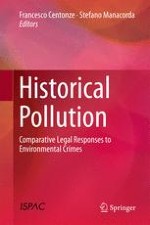2017 | OriginalPaper | Chapter
4. Historical Pollution and the Prominence of Criminal Law Enforcement in Italy
Author : Giuseppe Rotolo
Published in: Historical Pollution
Publisher: Springer International Publishing
Activate our intelligent search to find suitable subject content or patents.
Select sections of text to find matching patents with Artificial Intelligence. powered by
Select sections of text to find additional relevant content using AI-assisted search. powered by
